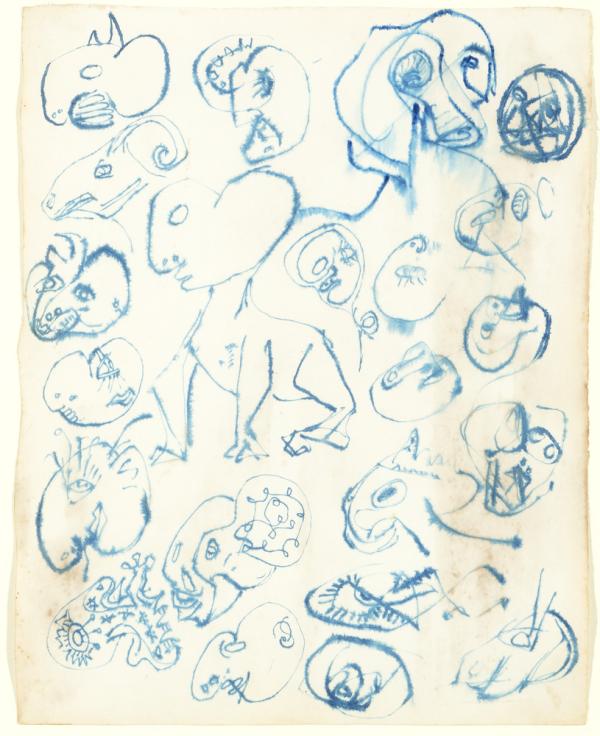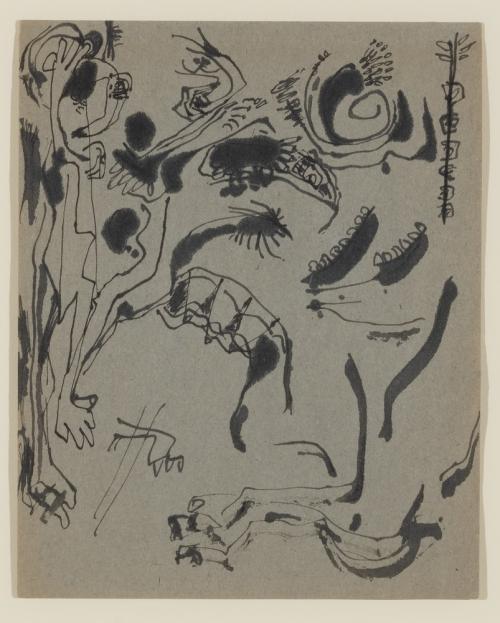Skip to main content
Untitled (Animal Figures)
Artist
Jackson Pollock
(American, 1912-1956)
Datec. 1939-42
MediumBlue ink
DimensionsUnframed: 13 x 10 3/8 in. (33.02 x 26.35 cm)
Framed: 25 1/8 x 19 1/8 x 1 1/8 in. (63.82 x 48.58 x 2.86 cm)
Framed: 25 1/8 x 19 1/8 x 1 1/8 in. (63.82 x 48.58 x 2.86 cm)
Credit LineCollection of the Modern Art Museum of Fort Worth, Museum purchase made possible by a grant from The Burnett Foundation
Object number1985.13
Status
Not on viewSignedverso, pencil, l.r.c., "Jackson Pollock before 1943/Lee Krasner Pollock1957/ bottom 8"
Copyright© The Pollock-Krasner Foundation
Category
Label TextDrawing was a critical force in Jackson Pollock’s development as an artist, and he used it effectively early in his career to sort out aspects of his life as well as his art. By the late 1930s, after he was diagnosed with acute alcoholic depression, friends and family persuaded him to seek professional help. In 1939, the artist began working with a Jungian therapist, Dr. Joseph L. Henderson. During sessions with Pollock, Henderson encouraged the artist to draw as a way to help him articulate his deeper thoughts. Pollock obliged by producing numerous sheets of drawings, many of which involved visionary figures that possess a combination of human and animal characteristics.
The Modern’s Untitled (Animal Figures), c. 1939–42, is a classic example of these drawings, which Pollock continued making after his involvement with Henderson ended in 1940. On a small sheet of paper, the artist created an entangled field of human/animal hybrids in meandering lines of blue ink. In the center of the sheet, a four-legged creature dominates the action. Part canine and part human, the image anticipates such breakthrough paintings as The She-Wolf, 1943 (The Museum of Modern Art, New York), inspired partly by the wild animal of classical legend who suckled Romulus and Remus, the twin founders of Rome. Even if the artist had not undergone Jungian analysis, he would very likely have been aware of the psychologist’s linkage between the modern individual unconscious and the creation of archetypes in myths and legends throughout history, as Jung’s ideas were a popular subject of debate at the time.
The Modern’s Untitled (Animal Figures), c. 1939–42, is a classic example of these drawings, which Pollock continued making after his involvement with Henderson ended in 1940. On a small sheet of paper, the artist created an entangled field of human/animal hybrids in meandering lines of blue ink. In the center of the sheet, a four-legged creature dominates the action. Part canine and part human, the image anticipates such breakthrough paintings as The She-Wolf, 1943 (The Museum of Modern Art, New York), inspired partly by the wild animal of classical legend who suckled Romulus and Remus, the twin founders of Rome. Even if the artist had not undergone Jungian analysis, he would very likely have been aware of the psychologist’s linkage between the modern individual unconscious and the creation of archetypes in myths and legends throughout history, as Jung’s ideas were a popular subject of debate at the time.







